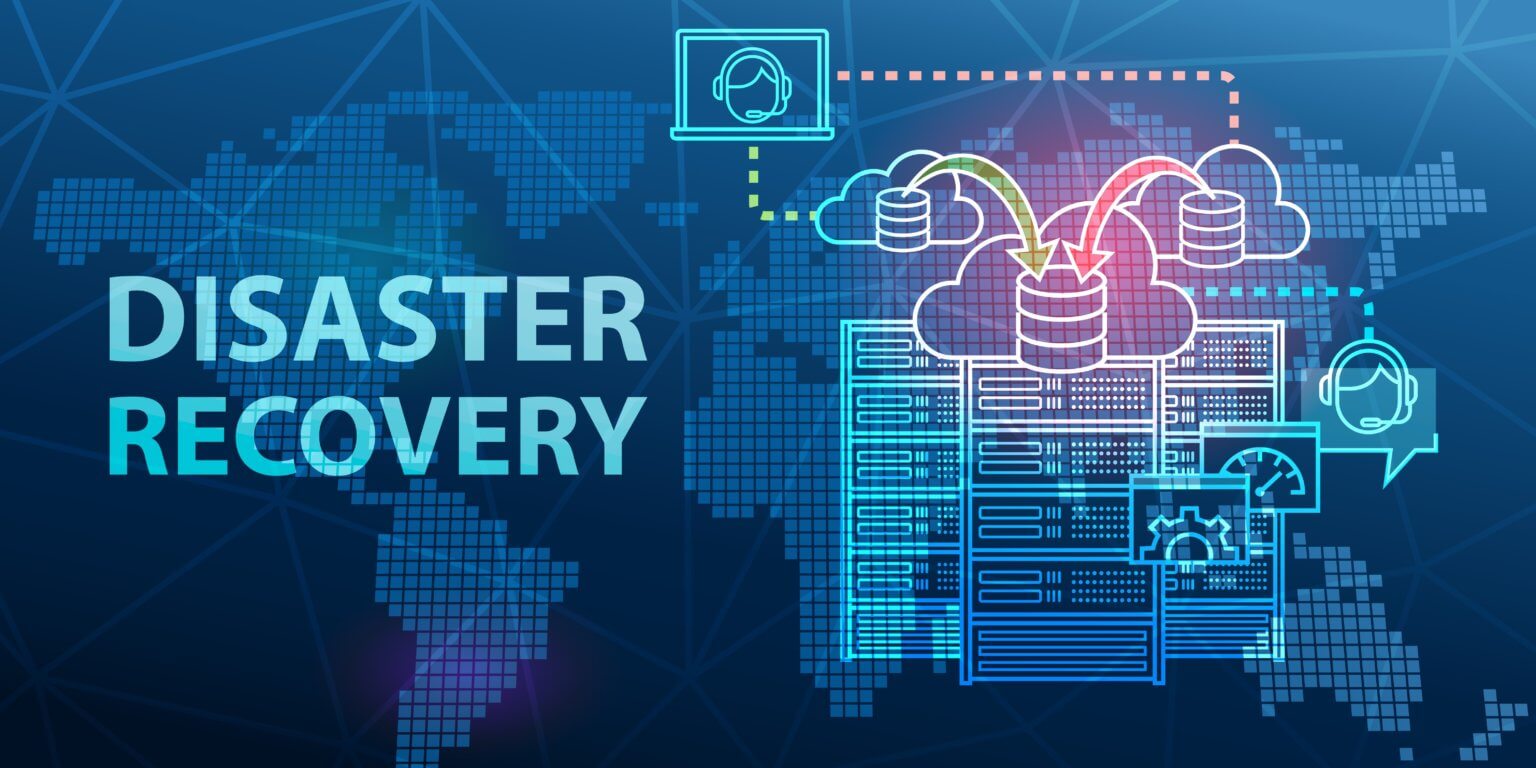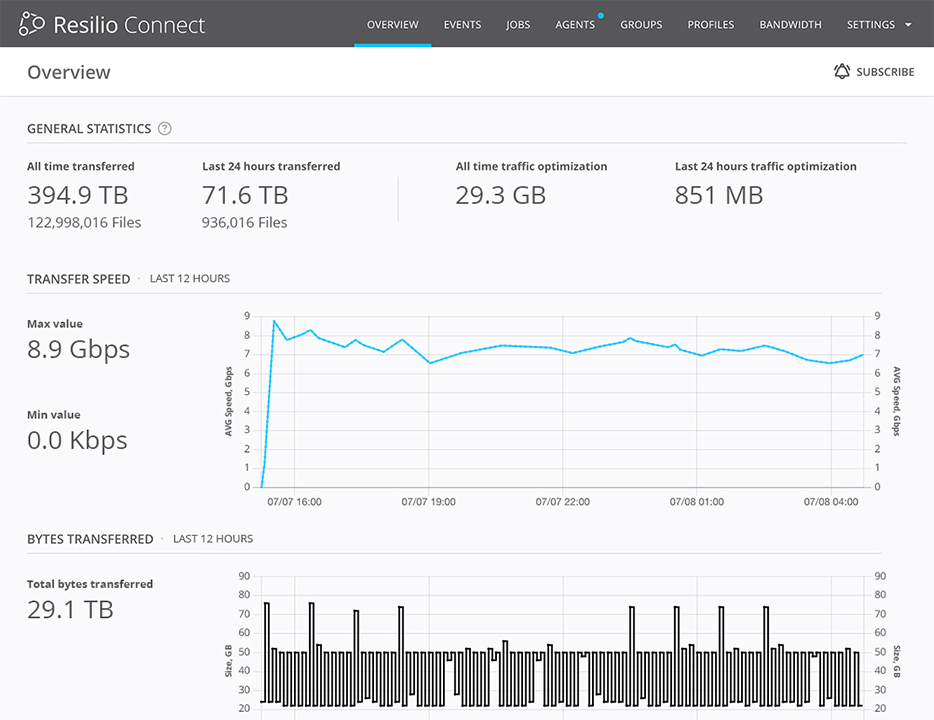Extend your on-premises IT infrastructure to improve RTOs and RPOs and enable active-active high availability using any cloud—across any global cloud region or location.
DR In the Cloud using Resilio
There’s been some justified hype around DR in the cloud. It’s hard to argue with the higher levels of availability and improved service level agreements (SLAs) offered by public cloud providers. At first glance, cloud computing comes at a price, with egress fees and ongoing pay-as-you-go for compute and storage services.
The good news is that Resilio offers a highly reliable and cost-effective cloud DR solution to efficiently replicate files across all on-premises locations and the cloud. Fun fact: using Resilio, you can optimize and “pin” traffic to your service provider network to avoid egress fees when replicating files across cloud zones and regions.
Another way Resilio enables cost-effective cloud DR is through a capability called selective sync. Resilio can be used as a global file cache for any type of on-premises storage that enables users to browse and selectively download files stored in remote cloud object stores. Essentially, your on-premises file servers become file caching gateways and file shares can be mounted by local users over SMB—just as they normally would.
The primary reason to consider Resilio for cloud disaster recovery is to meet (or even exceed) your business continuity and disaster recovery plans to reduce downtime and minimize data loss. Resilio’s real-time, low latency DR solution helps organizations meet recovery time objectives (RTOs) and reduce data loss through (in some cases) sub-five-second recovery points, as defined in your recovery point objectives (RPOs). Resilio’s disaster recovery solution is multicloud and can use any cloud infrastructure.
Another key requirement in your DR plan may be the need for active-active high availability across multiple sites, including one or more cloud regions. Unlike traditional DR, Resilio makes it easy to use any cloud infrastructure combined with your on-premises file servers and storage to protect files in real-time. Resilio supports any S3-compatible service provider including the big public cloud providers: AWS, Azure, Google Cloud, and Oracle Cloud, among others. Resilio runs on physical servers and virtual machines in a variety of environments from Microsoft, VMware, and Citrix.
From a replication perspective, Resilio gives you true bi-directional (two-way) and N-way (full mesh) replication and sync across all of your sites, on-premises and cloud.
Other ways Resilio Connect helps your cloud DR plan are by:
- Replicating on-premises file servers to any type of S3-compatible cloud storage.
- Enabling active-active high availability across all on-premises servers and cloud sites.
- Protecting and migrating files across different operating systems, devices, and virtual machines (smart phones, desktops, servers, NAS, or any endpoint running a Resilio Connect agent).
- Reducing ongoing costs of the cloud through smart routing and selective sync to minimize egress traffic.
- Providing a centralized, automated, and easy to manage global multicloud solution for DR in the cloud.
Disaster recovery in the cloud should protect files, minimize costs, and ensure files are always available in the event of a natural disaster or unplanned outage. You may have files spanning the globe located on file servers in branch offices, data centers, and potentially a variety of cloud providers’ storage services.
We’d love the opportunity to show you how Resilio works. Please schedule a demo to find out more, or keep on reading.
Scenario 1: Cloud Disaster Recovery for Hybrid Clouds
Let’s say you have 1 or 2 data centers running Windows Server or NAS and possibly a few branch offices also running Windows Servers. You want to incorporate Azure Files—or Azure NetApp Files—and you need your DFS namespace to span all locations.
Azure File Sync is not an option because you have some very large files, many millions of files and objects, and don’t feel like provisioning hundreds of management points to work with Azure Files. You also need scalability, reliability, and the ability to go multi-cloud at a moment’s notice. There may be a need to support projects on AWS or Google Cloud in the future.
DFSR is not an option because it’s proven to be completely unreliable, performs poorly, and lastly not supported in the Azure cloud.
There are a variety of disaster recovery strategies but the easiest may be to simply run a Resilio Connect agent on each of your file servers and cloud regions. Resilio rapidly replicates files of any size and type—and up to hundreds of millions of files—across as many on-premises and cloud endpoints as needed. The solution works with Azure Files, Azure NetApp Files, and most any cloud file and object storage, giving you tremendous flexibility implementing DR in the cloud.
Resilio’s disaster recovery solution makes it easy to incorporate cloud infrastructure from any service provider—and extend your organization’s DFS namespace (DFS-N) to the cloud. Resilio gives you an easy way to replicate files in real-time across multiple locations and sites, including any cloud region or cloud zone.
Scenario 2: Resilio as a Global File Cache and Storage Gateway
In cases where files need to be cached on-premises for data protection or to be accessed locally, you can use Resilio Connect and a capability called transparent selective sync (which looks and feels a bit like Microsoft OneDrive) to browse remote cloud stores like a file system and select which files you want to download and cache on-premises. This ensures only the needed files are downloaded. Policies can be set to purge cached files. You can also use Windows Server and Active Directory to delegate access to which users or groups have privileges to use selective sync.
That way you control who can download files from the cloud.
Learn more about Resilio solutions for global file cache management and storage gateways, here.
Scenario 3: Cloud DR for Remote Work and Hybrid Work
Many organizations have already pivoted to support remote work and hybrid work. Yet the idea of backing up individuals’ remote PCs and Macs is impractical at scale. How are you going to seamlessly get all of their files (including the really big ones) and permissions backed up and into the cloud?
With Resilio Connect for cloud DR—you can automatically protect everyone’s files without any user or administrative involvement.
Unlike Dropbox and Google Drive, Resilio has no limits on file sizes, numbers of files, or network bandwidth. For example, you could be a video editor shooting 8K footage on location. You may want to upload your files to the cloud for collaboration but that asset is now also protected in Wasabi’s or another cloud providers object stores. It’s a highly reliable collaboration with DR solution for organizations that require both global collaboration on large files—like a self-hosted alternative to Dropbox and Google G-Drive—and complete end-to-end data protection of all files, using the cloud.
Is DR in the cloud right for remote workers in your organization? The answer is yes if you need:
- Built in security: You need to protect files from cyberattacks and other threats by keeping an up-to-date copy for DR in the cloud. You need to make sure that your security policies are in place to protect all files, irrespective of the user’s location.
- Fast file access for remote work and hybrid work, from anywhere. When remote workers are accessing files across their home networks (Wifi) or broadband you need a reliable and predictable way to sync files in the least amount of time possible.
- Ease of use with minimal support. Once installed, the Resilio solution “just works” with a variety of home and Wifi networks and doesn’t require IT support or hand holding.
- Cross-platform solution: Your company may support a diversity of devices and operating systems: Windows, macOS, Android, Linux.
In one example, a company (let’s say Company C), is growing rapidly. With more than 1,000 employees across two locations and a large number of remote workers, they were looking for a solution that could work seamlessly across both places. With multiple office locations and their own independent networks, their IT team had to find something that was easy-to-use yet robust enough to handle the technical requirements of file sharing over the internet.
According to one customer at Company C, the Resilio Connect user interface is so simple: “After we got started with Resilio Connect, our IT team realized how much time they were saving with its automatic syncing capabilities (especially when compared with Dropbox). We also liked how easy it was for us users since all we had to do was drag-and-drop files into our Resilio folder on one computer in order for them to show up automatically on another computer running the Resilio Connect agent.”
When combined with Azure Files, Resilio Connect is a great cloud DR solution for remote work in Azure.
Scenario 4: DR in the Cloud for Branch Offices
You may have a number of branch offices—including a variety of devices running Windows, Windows Server, macOS, or other operating systems. You may or may not have a central data center or DR site. There may be a dedicated file server or two, and a few network shares (or mapped drives) housing business critical files that users need access to, and mount via SMB (when in the office).
But your goal is to simply provide a highly reliable and cost-effective DR solution—with the added benefits of reducing complexity, reducing management time, and eliminating the pain of troubleshooting DFSR and/or backup jobs at each branch office.
Also, your employees (end-users) don’t have to learn anything new. The exact same workflows can be supported by Resilio Connect—but with virtually zero remote management. It’s cost-effective to deploy an agent on each file server to replicate to the cloud, or alternatively an agent on each desktop. You’d want to run Resilio Connect natively on the client system if the end-user needs to share files with other remote users, or needs direct access to the cloud.
An added bonus is WAN optimization. Resilio gives your team the ability to use any network—across any distance—to sync and share files of any size and type in real-time and at the fastest speeds possible.
If you’re familiar with distributed storage challenges, compare and contrast the Resilio approach to a traditional hub-and-spoke global file system architecture. In the GFS model, all file changes need to be replicated and synchronized back to a centralized hub before changes are propagated out to other users. If your files are large or change often, these hub-and-spoke global file systems are hugely problematic. In the Resilio model, your changes can be immediately and directly sent to the people that need the updates. So if your files are changing at the edge, Resilio is much faster and more efficient than global file cache (GFC) and other GFS storage caching appliances from vendors like Nasuni, Panzura, and PeerGFS.
Scenario 5: Active-Active HA + Cloud DR for VDI
Resilio supports multi-site VDI environments requiring active-active HA with one or more sites in the cloud. A key advantage is that performance actually improves as you add more locations. Contrast this to FSLogix Cloud Cache where performance degrades as more sites are added.
Consider the need for two-way (vs. one-way) replication across 2 data centers. This could be all on-prem, a hybrid cloud, or cloud native. Resilio gives you a way to keep all sites active—there could be 2 or 20 or 2000 or more locations. By active-active we mean that all sites are serving VDI users concurrently. If there’s an outage, you can use global load balancing combined with Resilio Connect to redirect users to the closest site or one with the least amount of latency.
From a disaster recovery and high availability perspective, Resilio gives you fast and reliable bidirectional replication for user profiles, user stores, and other file-based data. You can replicate VHDs, Office files, file systems, file shares and folders stored on DFS or most any NAS or file server. With or without Microsoft DFS. Check out my recent blog, Active-Active High Availability for Citrix User Profile Management and VMware.
Other key capabilities
End-to-End Security
One of the most critical aspects of any DR plan is encryption and end-to-end file-level security. As with any IT system, it’s not just about the network and it’s not just about the files at rest and in transit—moving from system to system. Your DR plan likely requires security measures to prevent data loss in the event of a disaster or unplanned disruption.
Resilio Connect provides complete native security end-to-end for files at rest and in motion. There is no reliance on 3rd-party security packages, VPNs, or ad hoc cloud services. The system utilizes cryptographic security built on industry standards to achieve maximum protection. OpenSSL cryptographic libraries are used in addition to the operating system provided cryptographic APIs.
All implementations (on-premise and cloud) can be air gapped. Other features include:
- Mutual authentication and authorization of clients and Management Console
- Generation of one-time session encryption keys between clients
- Data in transit encryption
- Data integrity validation
- Standard encryption protocols: TLS 1.2, AES-256, SHA2
See the Resilio security white paper for more information on Resilio’s implementation.
Resilience for Cloud DR
Inadequate resilience is one of the biggest risks to your data in a disaster. A single point of failure can lead to data loss, which is why it’s important to ensure that you have sufficient redundancy and data integrity for files in motion. Resilio preserves file integrity, prevents corruption, and eliminates all single points of failures when replicating and synchronizing files.
Achieving adequate resilience requires:
- File-level data integrity: Files in transit must always be protected against corruption through checksums and integrity verification.
- Distributed architecture: An intelligent global file replication engine that allows for multiple endpoints to concurrently send and receive files. Resilio employs a peer-to-peer (P2P) architecture where all endpoints distribute files in parallel.
- Dynamic routing: An intelligent replication engine that dynamically routes file replication around failures, automatically, without any manual intervention.
- Continuous file protection for files in motion. Files should be protected across multiple endpoints. If any endpoint fails, all files remain available to other endpoints.
- Eliminate or reduce manual steps, and scheduled steps. In the Resilio model, manual backup is eliminated. If an outage occurs, files remain consistent, current, and available at other locations: so you can restore files on a failed endpoint by simply rejoining the device to the job in the Resilio management console.
Network Flexibility: Use Any Connectivity—Any Bandwidth
The Internet is not always available. Outages occur. In other cases, such as in VSAT, radio, cell, and some WiFI networks, the conditions are extremely poor—with unpredictable levels of latency and packet loss.
You need a cloud DR solution that works predictably and reliably, even when outages occur, or conditions degrade to extremely poor levels. When users can’t access the network, the cloud, or their Internet connections are slow, unreliable or degraded by adverse conditions—the systems need to keep working.
You need to replicate files quickly and in real-time, irrespective of the network conditions or when bandwidth is very low. If you’re in an emergency situation where there are no internet connections at all, Resilio will help you move your important data through whatever means are available to get it safely stored far away from your office or home.
Resilio Connect offers resilience and predictability during outages—and over poor network conditions. If an endpoint is disconnected from the network, users can continue working on their files and then Resilio will reliably and efficiently send the changes when the user reconnects.
Superior DFS Replication and Azure Files Replication
DFS Replication (or DFSR) is a feature of the Microsoft Windows Server DFS Namespace service that enables you to replicate folders from one server to another. Azure File Sync (AFS) is a basic sync tool from Microsoft to sync files from on-premises Windows Servers to Azure Files.
Resilio offers a turnkey replacement for both DFSR and AFS that fully supports the Azure Files, Azure NetApp Files, and a variety of hybrid cloud scenarios using your choice of storage. Moreover, the solution is turnkey and multicloud ready: Resilio’s solution for DFSR Replacement offers a seamless DFSR and Azure File Sync alternative that works out-of-the-box with the Microsoft DFS Namespace—using any cloud providers’ servers and storage services.
Check out the Resilio customer case study on high availability for DFS replication.
A few of the benefits of using Resilio Connect for DR in the cloud combined with your DFS namespace include:
- Resilience and reliability. Resilio Connect always works reliably and predictably so you can gain peace of mind knowing your files are replicated in support of your DR goals.
- Speed and scale. Resilio Connect gains performance as bandwidth increases—and as the number of DFS servers increases. Each DFS server runs Resilio Connect and participates in file replication. The file replication process is distributed across each DFS server.
- Peace of mind—and saved time. Instead of continuously battling the DFS “backlog” of changes and diagnosing problems on DFSR, you’re free to work on your DR plan. Or head off to the beach. Resilio works in the background, automated and hassle-free. One customer saved 13 hours per week of DFS replication administration time.
Flexible Deployment Models
When your disaster recovery plan includes Resilio, you can be assured that all of your files across all locations—from edge to branch offices to on-premises data centers to the cloud—will be protected and available at the fastest speed possible. Resilio Connect can be hybrid, multicloud, or entirely cloud-native, and requires no additional software installation to get started sharing files across your network. It’s easy enough that anyone in the business world could use it—which means no expensive integrations. In addition to being easy to install, Resilio Connect also offers an intuitive interface that makes it simple to learn how to use the product (and easily share files).
Why Resilio for Disaster Recovery in the Cloud
Resilio Connect enables you to meet and exceed your RPOs and RTOs in support of service level agreements and a variety of DR strategies. Resilio cloud DR solution is cross-platform, agent-based solution that is easy to set up and use. Resilio Connect you can:
- Protect all unstructured data in the enterprise–from personal files to critical business data. Files can be stored on any type of storage: DAS, NAS, SAN, Cloud Object Storage, or Cloud File Storage.
- Hands-free management across up to hundreds of thousands of devices; no need for manual uploads from one device to another.
- Automate backup and synchronization so there’s no stress if a failure or outage occurs.
Unlike traditional DR, Resilio makes it easy to use the cloud to protect files in real-time using your choice of on-premises data centers and cloud providers such as AWS, Azure, Google Cloud, and Oracle Cloud. Resilio’s low latency, real-time file replication protects files of any type and size across sites to meet sub-five-second RPOs (Recovery Point Objectives) and RTOs (Recovery Time Objectives) within minutes of an outage.
Key advantages of the Resilio architecture include:
- Real-time low latency: Instantly sync files to meet RTOs in minutes and RPOs in seconds.
- Resilient and highly available: Resiliently replicate files across multiple cloud zones and cloud regions setup for multi-site active-active high availability.
- Scale-out performance: Rapidly replicate up to hundreds of millions of files concurrently using any network (LAN or WAN) and across as cloud zones and cloud regions as needed.
- Your choice of IT infrastructure, storage services, and cloud provider. Use any type of server and storage, on-premises data center, or cloud storage on-demand. Optimize your multi-cloud architecture for capacity, performance, and cost savings.
- Automation for easy replication and data backup. All file replication and sync jobs are fully automated and centrally managed for as many global locations and sites as needed. The solution is “set it and forget it” and just works in the background.
With Resilio Connect, your company can better prepare for the future by ensuring all sensitive are protected when disaster strikes. We’d appreciate the opportunity to learn more about your goals and needs. Please feel free to schedule a demo or start a free trial to see if Resilio Connect can help your company deploy DR in the cloud.






